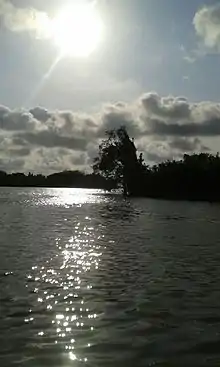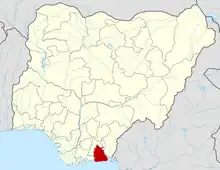Eastern Obolo
Obolo agan̄ Mbum-ura | |
|---|---|
| Country | |
| State | Akwa Ibom State |
| Government | |
| • Type | Local Government |
| • Chairman | Abraham Matthias Odion |
| • Density | 1,700/sq mi (670/km2) |
| Time zone | UTC+1 (WAT) |
Eastern Obolo (or Obolo agan̄ Mbum-ura in the native Obolo language) is a Local Government Area (LGA) in southern Nigeria, with its headquarters at Okoroete. It is a coastal local government area in Akwa-Ibom State under great tidal influence from the Bight of Bonny. Eastern Obolo LGA was mapped out of Ikot Abasi LGA by the Federal Government of Nigeria on 4 December 1996 with over 30,000 residents across a total area of approximately 17,000 km2. It comprises 16 villages, divided into two clans, namely Okoroete and Iko. It has ten political wards. All the villages in Eastern Obolo are of the Obolo ethnic group, there exist a common ancestral lineage which allows for peaceful coexistence and inter-relationship amongst them.[1][2][3][4][5]
Climate
The climate at Obolo, which has an elevation of None meters (0 feet) above sea level, is classified as tropical wet and dry or savanna (Aw). The district's average annual temperature is -0.81% lower than Nigeria's averages at 28.65°C (83.57°F). Obolo generally experiences 195.31 wet days (53.51% of the time) annually with average precipitation of 160.69 millimeters (6.33 inches).[6]
Location

Eastern Obolo is located in the Niger Delta fringe between Imo and Qua Iboe Rivers estuaries and lies between latitudes 4° 28' and 4° 53' and longitudes 7° 50' and 7° 55' East. It is bounded to the north by Mkpat Enin Local Government Area, northeast by Onna, west by Ikot Abasi, southeast by Ibeno Local Government Area and in the south by the Atlantic Ocean.[7]
Culture
The cultural heritage is not restricted to the people; rather, to the entire Niger Delta with unique traditional dressing synonymous with "Etibo" and "Wurkor".
Natural resources
Eastern Obolo has abundant mineral deposits [8]with onshore and offshore oil wells at Elek-Okpoon̄, Iko, Otunene, Emeroke, Ikonta and Obianga. There is a fishing settlements at Educwink, Elek-Okpoon̄, Agan-asa. Forest reserves include mangrove, iroko, raffia, rubber, kolanut, coconut, peas, and mango.
Commerce
The people of Eastern Obolo are predominantly fishermen, with over 65 per cent involved in active fishing.
People
The people are a combination of Obolo ethnic group and Iko extractions; strong cultural affinity exists among the people. It has a total landmass of 117,008 square kilometers with an estimated shoreline about 184 km long. Obolo language is the major language of the people as the different communities speak different dialects of Obolo, which are mutually intelligible. The Iko dialect spoken in Iko clan and is intelligible to a large number of people in Eastern Obolo. Iko dialect is closely related to Obolo and to the Okoroutip dialect spoken in Ibeno LGA, the sister/twin LGA of Eastern Obolo.
Population
The community population is predominantly the Obolos(75%), Ibibio and Ibo make up the remaining population. Emigration activities in the community is as a result of low productivity due to poor fish catch, limited farmlands, and the high rate of unemployment.
References
- ↑ "Coconut Oil Refinery project: A-Ibom govt assures community on compensation". Vanguard News. 2017-03-22. Retrieved 2017-03-22.
- ↑ "A/Ibom to compensate community in establishing coconut oil refinery". BusinessDay. 2017-03-20. Retrieved 2017-03-22.
- ↑ "Ikot Abasi, Mkpat Enin, Eastern Obolo LGAs get coconut plantation, refinery". theeagleonline.com.ng. Retrieved 2017-03-22.
- ↑ Ndimele, Ozo-Mekuri (2016-02-22). Language Endangerment: Globalisation and the Fate of Minority Languages in Nigeria. M & J Grand Orbit Communications. ISBN 9789785412727.
- ↑ Ndimele, Ozo-Mekuri; Constatine, Yuka, Lendzemo (2016-07-25). Issues in Contemporary African Linguistics: A Festschrift for Oladele Awobuluyi. M & J Grand Orbit Communications. ISBN 9789785412789.
{{cite book}}: CS1 maint: multiple names: authors list (link) - ↑ "Obolo, Enugu, NG Climate Zone, Monthly Averages, Historical Weather Data". weatherandclimate.com. Retrieved 2023-10-04.
- ↑ "Eastern Obolo ( EO) | The Obolo People's Website". 2018-05-21. Retrieved 2021-09-13.
- ↑ "Oil Exploration in Eastern Obolo Environment, 1996 – 2021". International Journal of History and Philosophical Research (IJHPHR). Retrieved 2024-01-13.
http://www.helloakwaibom.com/eastern-obolo-lga/ Hello Akwa-Ibom
